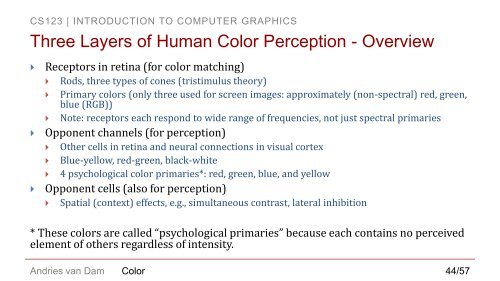Introduction to Color - Brown University
Introduction to Color - Brown University
Introduction to Color - Brown University
Create successful ePaper yourself
Turn your PDF publications into a flip-book with our unique Google optimized e-Paper software.
CS123 | INTRODUCTION TO COMPUTER GRAPHICS<br />
Three Layers of Human <strong>Color</strong> Perception - Overview<br />
<br />
<br />
<br />
Recep<strong>to</strong>rs in retina (for color matching)<br />
<br />
<br />
<br />
Rods, three types of cones (tristimulus theory)<br />
Primary colors (only three used for screen images: approximately (non-spectral) red, green,<br />
blue (RGB))<br />
Note: recep<strong>to</strong>rs each respond <strong>to</strong> wide range of frequencies, not just spectral primaries<br />
Opponent channels (for perception)<br />
<br />
<br />
<br />
Other cells in retina and neural connections in visual cortex<br />
Blue-yellow, red-green, black-white<br />
4 psychological color primaries*: red, green, blue, and yellow<br />
Opponent cells (also for perception)<br />
<br />
Spatial (context) effects, e.g., simultaneous contrast, lateral inhibition<br />
* These colors are called “psychological primaries” because each contains no perceived<br />
element of others regardless of intensity.<br />
Andries van Dam<br />
<strong>Color</strong> 44/57
















